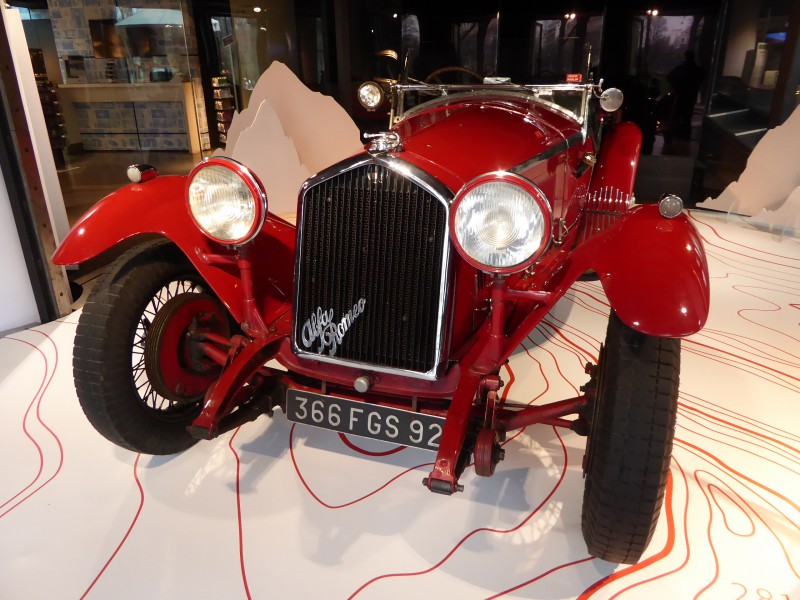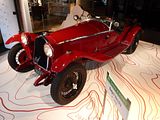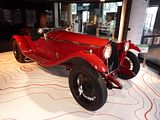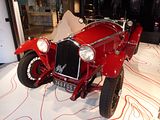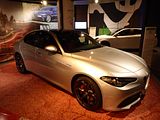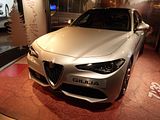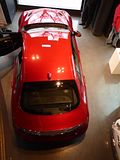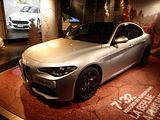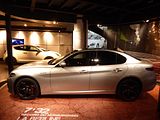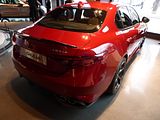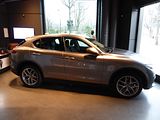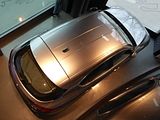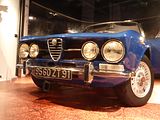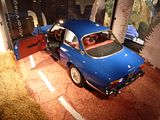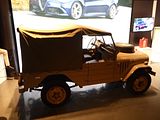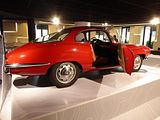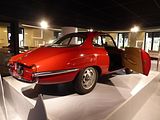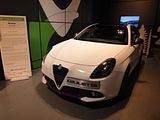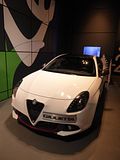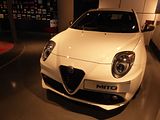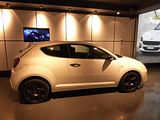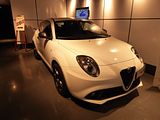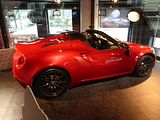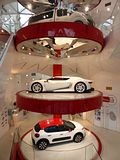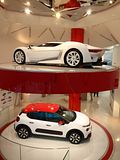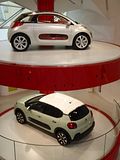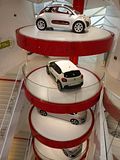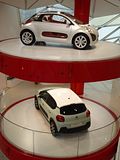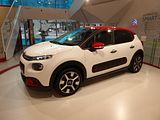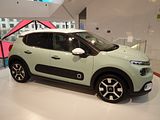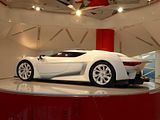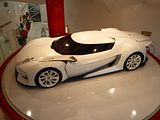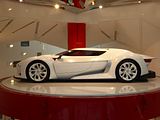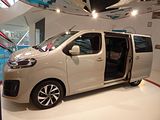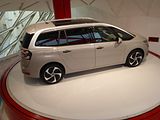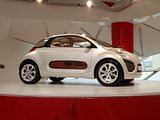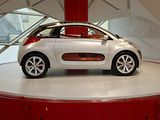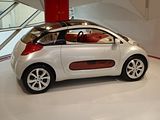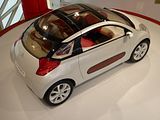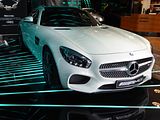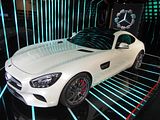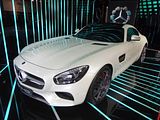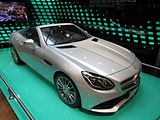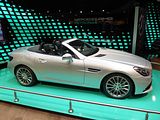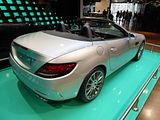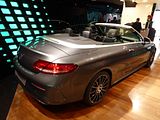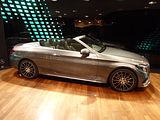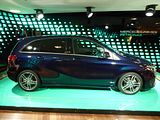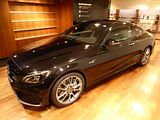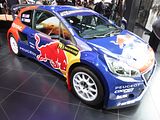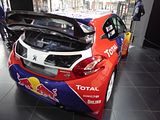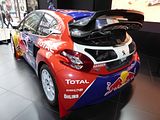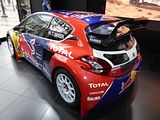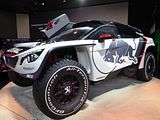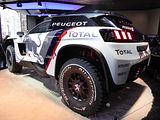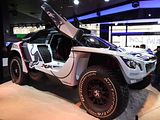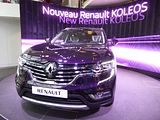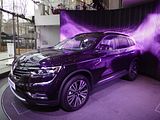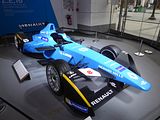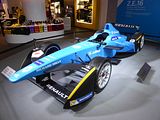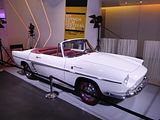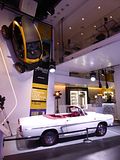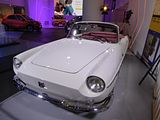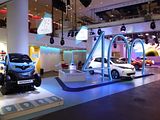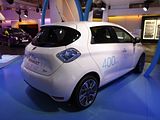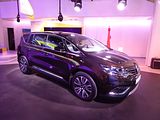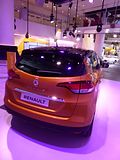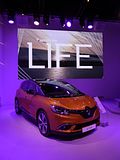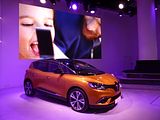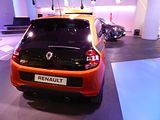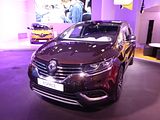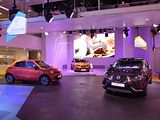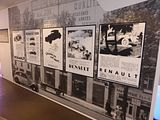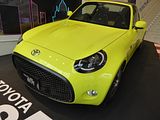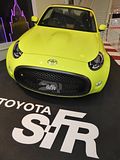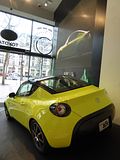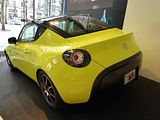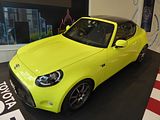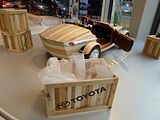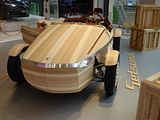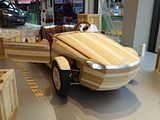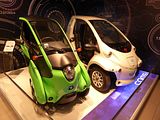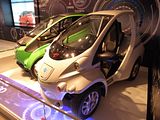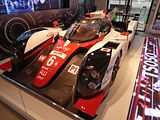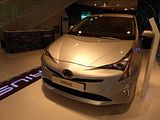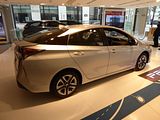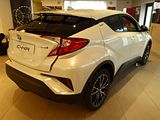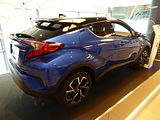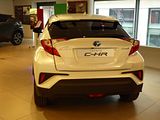Over the years that I’ve been visiting Paris, I’ve generally managed to fit in some time right in the heart of the city, meandering up and down the Champs-Élysées. With the spectacular Arc de Triomphe at one end, and some imposing former royal palace buildings at the other, there’s plenty to draw you back time and again, and of course the Champs-Élysées itself is a splendid wide boulevard, lined with an array of shops, boutiques and restaurants, many of which definitely come in the “it’s OK to look, but keep a firm grip on the credit card” category. Among them are four addresses of particular interest to the car enthusiast, and there’s a fifth just off the Champs-Élysées. None of them are really there as the central Paris location where you can buy the brand’s product in question, though if you were serious, I am sure you could. Instead, they are present for brand awareness, used to generate an interest in the latest thinking and product from the respective manufacturers, combined with large doses of history and heritage. Large numbers of people meander in, make a fairly cursory inspection of the displays and move on, with this seeming to be a particular popular thing for people to do as part of their Sunday morning stroll. For the enthusiast, it is always worth lingering a little longer. Considerable effort goes in, not just to the selection of cars, but the associated displays that go with them, so there is always something interesting to see and to learn, as well as a chance to sit in some of the latest models. The displays are changed pretty frequently, so for someone who only visits Paris a couple of times a year, you can be sure of seeing something fresh. This reports presents what was on display in February 2017 when I spent a good couple of hours between the five showrooms, on the day after I had been at the Rétromobile exhibition.
ALFA ROMEO
The products of the Fiat Chrysler Automotive Group are displayed in the Motor Village. This is the showroom which is not actually on the Champs-Élysées itself, but on the corner of a junction just a few yards to the north. The building is tall, covering several storeys, but with a small floor area at each level. There’s a rather nice restaurant on the top level and there is a cafe on the ground floor. Sometimes there is one example of each of the brands of the FCA Group, but this time, all the cars were Alfa models, in a exhibition called “Pass to Stelvio”. It had only just opened, and was timed to coincide with the French launch of the Stelvio SUV.
This fabulous 1931 6C 1750 Zagato was on the ground floor. I suspect it was sourced with the view that it would be the star attraction of this display, and as far as I am concerned, it certainly was. My love of these early 1930s Alfa model is repeated often in articles on this site, and I never tire of seeing another one. Conceived by the brilliant engineer, Vittorio Jano, the 6C 1750 was built for racing, and it enjoyed plenty of success with drivers such as Tazio Nuvolari behind the wheel. As was common practice at the time, Alfa supplied the chassis and engine, and the customer was responsible for selecting a coachbuilder to provide the body. Many did, but to my eyes, it is these Touring Zagato models which are the most desirable.
Of course, the 6C was there just to be looked at, whereas the other two cars on the ground floor were open and the staff rather hoped people would want to get in them, and try them out for size and comfort. If Alfa is to survive and grow, then both these cars must deliver the sort of sales success which has eluded Alfa for a very long time. The Giulia has already been on sale for a few months, and has received universally positive reviews, suggesting it thoroughly deserves to do well. The Stelvio that was also on show must do the same, and, given the market’s love of SUVs at present, is very likely to outsell the Giulia model as production volumes ramp up.
Down a floor, there was a real star from Alfa’s past: the “105 Series” 1750 GTV. These cars are probably even more popular now than they were when new, and prices of cars in good condition have rocketed in recent years. Many have been converted for historic racing, but there are plenty of road cars left as well.
Down in the basement was the Alfa that many would scratch their heads about. This is a Matta, or more technically, a 1900M. Matta is the nickname it acquired (it means “mad”). It was developed in response to a request from the Italian Ministry of Defence, and was made in both military (AR 51) and civilian (AR 52) versions. The AR 51 (Autovettura da Ricognizione, “Reconnaissance Car”) was the result of the request of a light reconnaissance vehicle for use on paved, unpaved and mountain roads. The civilian version, the AR 52, came later, based on the military AR 51; several variants were made, adapted for use in agriculture, firefighting, and road maintenance. The Matta was powered by a 1884 cc twin cam, 8-valve inline-four engine with dry sump lubrication. The cylinder head was aluminium and featured hemispherical combustion chambers, while the engine block was cast iron. Output was 64 hp at 4,400 rpm. The Matta was built from 1952 to 1954, with 2,007 military AR 51s for the Italian Army and 154 civilian AR 52 units produced. In 1954, the Italian army abandoned the AR 51 and switched to the Fiat Campagnola, which was mechanically simpler.
On the top floor of the building, in what is almost like a display case, so the hardest car to see and certainly to photograph was this fabulous Giulia SS, short for Sprint Speciale, and it really does live up to the name, as it is rather special. The Sprint Speciale was first shown at the 1957 Turin Show as a prototype. Production cars were launched at the Monza circuit in June 1959. The SS boasted the lowest drag coefficient ever seen in a production car, with a cd of just 0.28, a figure which was not surpassed for 20 years. In 1963, it was updated, taking the Giulia name, when a larger 1600cc engine was put under the bonnet, giving it a top speed of 120 mph, an astonishing figure at the time. It did not come cheap, though, costing a lot more than the Giulia GT that was also first shown in 1963. 1,366 of the earlier Giulietta Sprint Speciale and 1,400 of the later Giulia Sprint Speciale were produced before production ceased in 1963. You don’t see these cars very often, and on the rare occasions when one comes up for sale, the price tag is high.
Also down in the basement were latest examples of the Giulietta and MiTo, both of which have received mild refreshes in recent months, in the hope that sales will continue whilst Alfa’s ponders their future and whether to replace them or not.
Final Alfa in the display was a 4C Spider. First seen as a concept at the 2011 Geneva Show, the definitive 4C Coupe model did not debut for a further 2 years. Production got underway later that year at the Maserati plant in Modena, and the first deliveries came late in 2013. Production was originally pegged at 1000 cars a year and a total of just 3500, which encouraged many speculators to put their name down in the hope of making a sizeable profit on selling their cars on. That plan backfired, and in the early months, there were lots of cars for sale for greater than list price. Press reaction to the car has been mixed, with everyone loving the looks, but most of them feeling that the driving experience is not as they would want. Owners generally disagree – as is so often the case! – and most love their car. The Spider model followed in 2015, with the first examples of these reaching owners around the turn of the year, and when these cars gather now, you are just as likely to see a Spider as a Competizione.
CITROEN
The dramatic Citroen building is actually the best starting point, for two reasons: most importantly, it is the first to open, with the door unlocked at 10am, whereas the others will make you wait until 10:30 or even 11am; and secondly, it is situated right at the top of the escalators up from the Franklin Roosevelt métro station. It is a particularly striking building, quite unlike anything else in the vicinity. Designed by Parisian architect Manuelle Gautrand, it was constructed between 2002 and 2007 as a new flagship showroom, according to a concept “intended to magnify the displayed cars in a building with strong symbolic presence”. The result, as well as housing a shop for branded goods is a kind of corporate totem composed of eight vehicles stacked on platter one on top of the other. The arrangement forms a gigantic upright display around which visitors move in an ascending/descending spiral movement via flights of stairs and landings. From the top, there are superb views up and down the Champs-Élysées, over the city and across the nearby gardens and river. The cars are displayed on revolving circular platforms under a faceted mirror-ceiling that fragments and multiplies their lines and details. Besides enhancing the presence of the display models, we are told that the “effect accentuates the vertical reality of space and creates an exhilarating sense of lightness”. Around this there is faceted glass which, so we are further told, plays on the distinctive shape of the Citroën logo: the chevron. At street level on the Champs-Elysées, the façade begins as a simple flat curtain wall. The double chevron soon appears, proliferating as it rises in free and inventive array right up to the summit. The glass front unfolds a gigantic origami, coloured by diaphanous white and red film that lets subdued clear light into the interior. Enough of the PR speak around the building, what of the cars?
Although the displays do change pretty frequently, I was a little surprised to see that the Citroen one had not done so since my last visit in mid October 2016 when I was over for the Paris Show. As I had taken lots of pictures of the cars on that occasion, from all the available vantage points, I did not take that many more this time, but in the interests of completeness, the exhibits are re-presented again here, and the photos I did take on this trip are here as well.
On the ground floor was a new C3, and a second one was displayed further up the building. In October, the car was brand new, and few would have seen one in the metal, let alone on the road, whereas by February, the new shape – the third generation of car to bear the C3 name – is starting to become a sight you will see on Parisian streets if you wait a few minutes and keep looking. Competing in the fiercely competitive supermini class, the new C3 has its work gut out in persuading people to prefer one over the domestic rivals of Clio and 208 as well as a dozen other competitors, almost all of which are pretty good. Unlike the second generation car, which was rather forgettable, this one could just do what is needed, and give the size of the market sector in which it competes, it is indeed critical for the success of a brand which seems to be rediscovering its mojo after a couple of decades of applying the “pile ’em high and make them cheap” mantra. The distinctive style all of its own, taking cues from the latest C1 and C4 Cactus models, the optional air bumps on the side, a contrasting coloured roof and careful choice from the list of optional colours all combine to make this new version looks more interesting than the model it replaces, and the interior quality has also taken up a huge leap forward.
On the next floor up was the GT Concept. It is hard to imagine, but this debuted as a concept car on October 2 at the 2008 Paris Motor Show, a collaboration between Citroën and the Japanese racing simulation developer Polyphony Digital. The GT by Citroën concept car was specially created, designed and produced for the video game Gran Turismo 5 and was included through download in its initial version Gran Turismo 5 Prologue. Its designer came up with the project and sold it to both Polyphony Digital and Citroën.The car’s exterior design was made by Takumi Yamamoto, a Japanese designer from Jean-Pierre Ploué’s Style Citroën design team. Takumi Yamamoto was a childhood friend of Kazunori Yamauchi, director of Polyphony Digital and creator of the popular Gran Turismo franchise, also known as “Gegge”. According to a Yamauchi interview at the Paris Motor Show 2008, he and Yamamoto started collaborating on this project back in 2003. Yamamoto convinced Jean-Pierre Ploué to submit his concept to Citroën’s head office in Paris who agreed to start the production process and manufacture the real car. Since Gran Turismo 5 Prologue, there have been three versions of the GT by Citroën: a road version with 500 hp; a race version, with 599 hp; and a concept version of 778 hp featuring a battery powering four electric motors. However, the real car uses a modified version of the Ford Modular V8 petrol/gasoline engine, producing 646 hp The car’s weight is 1,400 kg (3,086 lb). In June 2009, Citroën confirmed plans to produce an extremely limited number of GTs for sale to the public, with just 6 to be built, each costing $2.1 million. In July 2010, rumours that production was suspended began to surface, and sadly these turned out to be accurate, leaving the car as a true concept.
The Space Tourer is a large “people carrier” the result of a joint venture with Toyota, who offer a similar vehicle that they call the ProAce Verso. Stable mate Peugeot call their version the Traveller. All are spacious vehicles that offer space for up to 8 people and their luggage. It was premiered at the 2016 Geneva Show, and replaced the Jumpy, which had been produced for the previous 10 years in its outgoing form, and for 12 years before that. As before, this is a close relative of a medium-sized van, and that retains the Jumpy name, except in English speaking markets where it remains the Dispatch.
Up a floor was a C4 Grand Picasso. I did not know it at the time, but I was going to receive one of these the following day from Hertz France, as my rental for the day, so would get a chance for a far more considered assessment than you can get from sitting in one on a display turntable. The review for that test will be posted separately, but suffice to say that this is a practical car, well rated by the motoring press as the pick of its class.
The second concept car in this collection was the C-Airplay, which was presented by Citroën in December 2005 at the Bologna Motor Show. This is a 3-door, 4-seater city car. Its slightly rounded body shape is similar to that of the Fiat 500. One feature of the car is that the doors have tinted glass inserts in the lower half portion. Although it looked good when revealed, and indeed still does now, it did not proceed beyond the concept stage.
In the basement was an example of the C4 Cactus. I think this car looks tremendous, though I am warned by those who have driven one, that it does not quite measure up on the road, so perhaps it is as well I’ve not managed to get behind the wheel of a Cactus yet.
Of course there are plenty of Citroens out on the street, ranging from brand new models to ones from the back catalogue. The one that caught my eye was this fabulous Méhari, which was clearly doing tourist duty in the city. I think I would want to drive one rather than just be passengered in it!
MERCEDES-BENZ
There’s only space for 4 or 5 cars to be presented in the Mercedes showroom, and with such a vast range on offer, choosing them must be difficult. Mercedes usually choose a real head-turner to present at the front of their building, as this is the car that will pull in the crowds. When I was here in October they had a pearlescent white AMG GT-S in this position, and it was still the lead car for this visit as well. It certainly helps to bring the crowds in, as despite the lack of people in the photos, this was a busy place, though most people did not stay all that long, drifting from front to back and out again.
The middle of the showroom contained two of the same model types as were present on my last visit, as well, but as the colours were different, these were clearly different cars. Both were open topped models, and from the more affordable part of the Mercedes with built in fresh air. The SLC is the latest version of a car we all know, and probably still call the SLK. The badging was changed as part of Mercedes’ plan to try to make the naming of their cars more logical and consistent. Minor updates were made to the model at the same time.
Joining it was a C Class Cabrio. You really do have to look hard now, as the newly revealed E Class Cabrio looks almost exactly the same. All C and E body-styles are similar, and only when you see them side by side can you work out that the E models are that bit bigger, but it is the Cabrio cars that are the most like each other. The dash designs are different (for now), so one tip is to look inside if you can!
Towards the back of the showroom was a B Class and at the very back was another C Class, this one in the Coupe body style.
PEUGEOT
The Peugeot showroom, the one nearest to the Arc de Triomphe, is not large, with space only for 3 or 4 cars. Last time I was here, the emphasis was on the brand new second generation 3008, but this time, it was Peugeot’s recent activities in the world of motor sport which influenced the exhibits, with three very special cars on show.
To one side of the main door was the 208 WRX, a car piloted by Sebastien Loeb and Swede Lansen.
Fresh from its astonishing 1-2-3 success in the 2017 Dakar Rally was the new 3008 DKR. Driver teams of Peterhansel/Cottret, Loeb/Elena and Despres/Castera not only completed the 2017 Dakar Rally, but ended up on the top three steps of the final podium in Buenos Aires, Argentina, following a 9,000-kilometre run through Paraguay, Bolivia and Argentina, taking Peugeot’s score on this famous cross country rally to six outright victories. Peugeot till tell you that the all-new 3008 DKR challenger is inspired by the all-new Peugeot 3008 SUV, revealed at the 2016 Paris Motor Show, following eight months of intensive work in Velizy, France, since the Dakar finish ramp in Rosario. Looking at it, the links are quite tenuous! The new 3008 DKR’s dimensions and features are governed by technical rules laid down by the sport’s governing body, but its inspiration is still very clear through a number of unique design cues. The 3008 DKR remains loyal to Peugeot’s two-wheel drive philosophy, with the first Dakar win for a two-wheel drive car in 15 years ago, proving that you don’t necessarily need four-wheel drive to conquer the toughest landscapes in the world. Peugeot applied what they learned from the 2008 DKR in developing this car, going through every aspect of that car in fine detail in order to refine the package further, focussing both on mechanical strength and also complex electronic processes, such as engine management. Huge steps in driveability were made from the 2015 debut to 2016, but Peugeot Sport ensured that the new 3008 DKR’s 3.0-litre V6 twin-turbodiesel engine was even more driveable for the 2017 Dakar Challenge, delivering greater torque at lower revs. Adding to the challenge for the engineers is the fact that the latest Dakar regulations have imposed a smaller restrictor on the engine (38mm as opposed to 39mm last year) with a net loss of around 20 hp. However, this power is now accessible from further down the rev range, meaning that the new 3008 DKR is easier to drive and even faster. Suspension is one of the key elements to success on the Dakar, as it governs just how quickly the car can cover the ever-changing untrammelled terrain that is the hallmark of the Dakar, ranging from salt flats, to WRC-style gravel roads and sand dunes. The suspension was already one of the most impressive aspects of the Peugeot 2008 DKR for the drivers, but for the new 3008 DKR, further work was done on the geometry and dampers. The test programme up to now, which has included the 15-day Silk Way Rally – featuring quite similar terrain to the Dakar – was instrumental in furthering these important improvements. Although we now take air conditioning for granted on our road cars, it was only introduced to the 2008 DKR in Asia for Summer 2016 and it was made more effective for Peugeot Sport’s latest creation. With crews spending up to 12 hours a day inside the cars, subject to cockpit temperatures in excess of 60 degrees centigrade, the effect of air conditioning on human performance cannot be underestimated. Even though the drivers are super-fit athletes, the improved air conditioning helped them to perform at a higher level.
The older 2008 DKR was also on show. A joint venture between Peugeot, Red Bull and Total, the Peugeot 2008 DKR shared something of a family resemblance with Peugeot’s road-going 2008 crossover, albeit with more muscular forms and more imposing overall proportions that have been honed to meet the challenges of one of the worlds toughest events, in which Carlos Sainz and Cyril Despres were to compete. The 2008 DKR features an aggressive stance dictated by the technical constraints associated with its mission. There was a very precise brief for Peugeot’s Style Centre, with the basic key dimensions, as well as other information such as the cabin space required, plus the wheel size and the suspension travel. There was also aerodynamic data resulting from early simulation work. One question that Peugeot Sport’s design team had to answer at a very early stage concerned the new beast’s transmission: four-wheel or two-wheel drive? The decision effectively influenced the car’s design in two key areas: Having carried out an in-depth analysis of what already existed in the world of cross-country rallying and weighed up the benefits of the different solutions, Peugeot opted for an approach that was quite different to that of the competition. Given the off-road capability of two-wheel drive transmission and its ability to run on sand, that was the choice. It enabled the fitment of bigger wheels and allowed more suspension travel. The 2008 DKR consequently sits on 37-inch diameter Michelin tyres. A further bold choice as to use a diesel engine, making this car unlike its main rivals. The decision to go for a two wheel drive solution has another advantage: far less weight, as allowed by the regulations. The bigger wheels provide a certain advantage when it comes to coping with the many pitfalls associated with the type of terrain that will be encountered, and it is possible to minimise the front overhang. The 2008 DKR can practically climb vertical walls! And that’s not all! Longer suspension travel – 460mm instead of 250mm – enhances its ability over dunes and when soaking up uneven ground, a key asset on an event like the Dakar! Another advantage of the larger wheel size is a system that enables the tyre pressures to be adjusted remotely from inside the cockpit upon entering a zone of dunes – a tactic that could yield a gain of precious minutes! In order to exploit these benefits fully, Peugeot Sport’s engineers put their creativity to the test to come up with an extremely compact car. With its 340bhp, V6 twin-turbo diesel mid-rear engine, the 2008 DKR resembles a muscular feline ready to pounce and soak up obstacles. Fitting all of the vital assemblies into such a small space gave the designers quite a headache, but as small cars tend to perform more comfortably over twisty WRC-type stages, this arrangement increased the potential of two-wheel drive cars in situations where the 4x4s tend to have the edge. The car went on to win the event.
RENAULT
One of the larger of the showrooms, Renault has been on the Champs-Élysées for over 100 years, during which time the display space has changed a lot. There is a clear glass frontage to the “Atelier Renault” these days, which means that you can see two cars even before they unlock the doors, and, as has proved to be the case many of the times when I have visited, these were very different. To the left of the doors was the brand new Koleos. Although premiered at the Paris Show the previous October, this car has yet to go on sale. The car is on a turntable, but is off limits for people to get in it and have a look. That will have to come later in the year.
To the right of the door was a reminder that Renault has combined all the work that they have been doing on electric power into their Formula Z.E. 16 race car. This single seater consists of a Spark-Renault SRT_01E chassis with the Z.E.16 powertrain developed by Renault Sport Racing at its engine operations base in Viry-Chatillon, France. It has a single motor with a high grade permanent magnet and a single inverter integrated with the motor, which generates a maximum power output of: 200 kW (270 bhp, though in race mode, this is down to 170 kW (230 bhp), as regulated by FIA. Braking regeneration power is 150 kW regulated by FIA. The electronics are a combination of an ECU developed by MAT (McLaren Applied Technology) and control software developed by Renault. The chassis comes from Spark, which is used by all series entrants. The tub is carbon-fibre, as are the front and rear wing including the spoiler, whilst the bodywork is a mix of carbon-fibre and Kevlar. Michelin bespoke 18-inch treaded tyres are fitted. The front suspension is a mix of steel wishbones and pushrods. The batteries, bespoke for all manufacturers, weigh: 350kg, generate 600 Volts with a capacity of 28 kWh ( FIA rules), giving a range of approximately 25 minutes in race conditions.
Star attraction once I got inside was this rather glamorous Floride Convertible. Although a very French product of its time, its inspiration comes from America. In the late 1950s, Renault was envious of the growing success in North America of the Volkswagen Beetle and were looking for ways they might match the Volkswagen’s success with their own Renault Dauphine. At a convention of North American distributors that took place in Florida, Renault’s US dealers called for the creation of a Dauphine coupé/cabriolet which would improve Renault’s image in the critical US market. Renault’s chairman, Pierre Dreyfus, agreed, and since the concept had been born at a convention in Florida the car instantly became known within the company as the “Renault Floride”. Ironically, the “Floride” name was considered unsuitable for 49 of the 50 states of the USA, however, since it could have implied disrespect to states other than Florida. For this reason an alternative name, “Caravelle”, was from the start used for North America and for other major markets (including the UK) where the principal language was a form of English. The Floride was unveiled at the 1958 Paris Motor Show. A small rear-engined design by Pietro Frua at Carrozzeria Ghia, it used the floorpan and engine of the Renault Dauphine. The car was offered as a 2+2 coupe, a 2+2 cabriolet and as a convertible, the latter being a cabriolet with a removable hardtop.The 89.2 in wheelbase was shared with the Renault Dauphine but longer overhangs meant that overall the Floride was longer by a significant 12.6 in, as well as being slightly lower and very slightly wider. At launch the Floride, like the Dauphine on which it was based, came with an 845cc four-cylinder water-cooled engine mounted at the back of the car. However, the power unit on the Floride was fed using a Solex 32 mm carburettor as against the 28 mm diameter of the Solex carburetor on the Dauphine. The Florides making their French show debut on the stand at the 1958 Paris Motor Show came with a claimed power output of 37 hp. By the time deliveries commenced, in early summer 1959, it was also possible for customers to specify a performance version, engineered by Amedee Gordini, which produced 40 hp by means of various modifications to the inlet manifold and camshaft, and a compression ratio raised from 7.6:1 to 8.0:1. Power was delivered to the rear wheels via a three speed manual transmission with synchromesh on the upper two ratios. For a supplement of 200 New Francs customers could instead specify a four speed transmission on the slightly heavier coupé version of the car. Having regard to the car’s power-to-weight ratio most customers chose to pay extra for the four speed gear box. Although designed by Frua of Italy, the car’s body was constructed locally, by the automobile body maker Société des usines Chausson, based in Asnières-sur-Seine at the northern edge of Paris, and known in France as the producer of many of the school bus bodies used for transporting children in country areas. In October 1959, the Floride, along with the Renault Dauphine, appeared with significant suspension improvements. The new suspension was conceived by the by now almost legendary automotive engineer Jean-Albert Grégoire and baptised by Renault “Suspension Aérostable”, being intended to improve the car’s ride and road holding. The addition of extra rubber springs at the front reduced roll and auxiliary air spring units (mounted inboard of the conventional coils) at the rear gave the rear wheels a small degree of negative camber and increased cornering grip. In March 1962, the Caravelle received a new 956 cc engine that would be also used by the new Renault 8 from June. Although the new “Sierra” series five-bearing engine shared no components with the existing 845 cc Dauphine engine, it was conceptually very similar: the engine size was chosen in order to come in (slightly) below the top of the 5CV car tax band in France. It had a sealed cooling system as well as a new front suspension, new rear geometry, new steering, and a new gear linkage. Moving the radiator behind the engine also freed up an extra 12 cm of space behind the front seat. Maximum power output increased to 48 hp. Four-speed transmission, already included in the price at no extra cost on some export markets, now came as part of the standard with the new engine even for French buyers, although bottom gear still made do without synchromesh The upgraded cars, first presented at the 1962 Geneva Motor Show, now featured disc brakes on all four wheels: the Floride was the first French volume car to benefit from this enhancement which also reduced unsprung weight by approximately 6 kg The Caravelle name also replaced the Floride name in all markets from 1962 onwards. In 1964 another R8-derived engine of 1108 cc was introduced to the Caravelle, producing 55 hp. This model was tested by “Autocar” magazine in November 1965, who found it had a top speed of 89 mph (143 km/h) and accelerated from 0-60 mph (97 km/h) in 17.8 seconds, with an “overall” fuel consumption of 30.2 mpg. The Caravelle’s performance closely matched that of the contemporary Triumph Spitfire 4 under most headings, though the Spitfire was a couple of mph ahead on top speed. The British car market was still protected by tariffs at this time, but even allowing for that the Renault looks expensive in this company: The Caravelle came with a UK recommended price of £1039 as against £666 for the Spitfire 4. Production got under way slowly, with only 3,777 cars completed in 1959. However, in 1960, following the important “Aérostable” suspension upgrades, Renault produced 36,156 Florides. By the mid-1960s the Caravelle, which had been fashionably styled at launch, was looking dated, while the reduction and elimination of internal tariffs within the Common Market led to intensified competition in France for buyers of inexpensive sports cars, notably from Italy. Between 1966 and 1967 annual production tumbled from 4,880 to 2,991. During 1968 only 1,438 were produced, and it was during the summer of that year that Renault withdrew the Caravelle.
Two of Renault’s electric cars featured in the centre of the showroom: the Twizy and Zoe, and there was another Twizy anchored at a rather parlous looking angle on the wall above the Floride.
Towards the back were three regular production cars. The latest Espace is not particularly familiar to those of us in Britain, as it is not imported to the UK, but it is now quite a common sight on French roads, having been on sale for a couple of years, and it was joined by the new fourth generation Scenic, recently on sale and the Twingo GT.
As well as the cars, there were also some fabulous period photos on the wall.
TOYOTA
The Toyota showroom is split over 2 floors. As is often the case, there is quite a contrast between the displays on each storey. It is not uncommon to find production cars featured upstairs, whilst downstairs there was a mix of concept and racing cars as well as a couple of production models.
On a plinth by the door was the diminutive S-FR Concept, a rather good-looking small sports car which was unveiled at the 2015 Tokyo Show. At just 157 inches long, 66 inches wide and a mere 51 inches tall, this is considerably smaller than the GT-86. Although its styling does look modern, it is clear that this is a heritage-laced design, inspired by the 1965 Sports 800, Toyota’s first-ever sports car. Inside, the coupe gets a simple, back-to-the-basics cockpit unabashedly designed around the driver. The centre console is pared down to only the bare essentials, and all car-related information is grouped in an easy-to-read single-pod digital instrument cluster. Notably, the S-FR is not equipped with a touch screen or with an infotainment system. Toyota have said little about the technical details of the car, but it is understood that it uses a 128- bhp 1.5-litre twin-cam engine borrowed from the Toyota parts bin. For sure, it has a four-cylinder engine mounted in front-mid position, with a six-speed manual transmission sending power to the rear wheels. Toyota say that the coupe is exceptionally light and agile. There has been much speculation as to whether something like it would make production. Enthusiasts will all be hoping it does.
Centre-piece of the ground floor display was this, the Camatte Setsuna, something I don’t recall even reading about and which I certainly had not seen in person before. It was unveiled at the April 2016 Milan Furniture Fair as a wooden roadster version of the Toyota Camatte electric chassis. The body has a similar shape to the Camatte57s but is made entire from Japanese cedar. The chassis is also similar to the Camatte57s but partially built using Japanese birch. The Camatte57s chassis provide 1+2 seating but the Setsuna is a more traditional 2-seater. The body panels are attached using traditional Japanese okuriari and kusabi joints, which don’t require nails and allow the panels to be removed and reattached.
Concepts that I have seen before were this duo, the smaller of which is called the i-Road. It has been presented at quite a few shows in recent years, having been first shown at the March 2013 Geneva Motor Show. There is an electric drive-train and its two 2-kilowatt (2.7-hp) motors are powered by a lithium-ion battery that can be charged using a household outlet. One charge has a range of 50 km (31 mi) and a top speed is 45 km/h (28 mph). It is designed for city use.It has no emissions at point of use. The vehicle is designed with 3 doors and 2 seats in tandem in a fully enclosed body. Car and Driver describes the Toyota i-Road as “something of a cross between a car, a motorcycle, and a fancy golf cart”. It is similar to the concept of a motorcycle but has three wheels. Toyota has developed what it calls “Active Lean”, a new technology that helps provide the centripetal force to make the vehicle go around a corner and smooths the ride over rough ground. “Active Lean” operates using an on-board computers on each side of the front suspension to calculate the degree of lean needed based on input from the steering mechanism, the gyroscope angle and speed. To compensate for road conditions, a front wheel is adjusted up or down as needed to stabilise the vehicle. According to Wired, this technology “allows you to bomb through the bends without tipping over.”Toyota refers to it as a “personal mobility vehicle”. The width is 850 mm (33.5 in), approximately the same width as a motorcycle, and four of these vehicles can be parked in a single parking space. It seats two people in an enclosed cabin that protects the occupants from the environment. Its turning radius is about 2.7 m (9 ft). Currently, the Toyota i-Road is a concept car envisioned for urban use in the future, and there are no plans for general production at this time, but 70 i-Roads have been deployed in Grenoble as part of a last-mile mobility project, managed within an existing car club. The i-Road has also been part of Toyota’s similar ha:mo project in Toyota City, Japan.
Joining it was the COMS ultra-compact electric vehicle, looking a bit like a glorified Golf Buggy, which was first shown in 2012. It has a price of around 798,000 yen, or around $10,000 US and is available in two options – P for consumers and B for delivery. This diminutive device can achieve a maximum speed of around 38 miles per hour and it has a range around 31 miles. Weighing around 881 pounds, the COMS is powered by an electric motor with a rated output of 0.59W. It is equipped with regenerative braking, which helps to restore power to the vehicle’s battery. Recharging time via a standard Japanese 100 volt home outlet is around six hours, and Toyota estimates it costs about $1.50 for a full charge.
Something really rather different was the TS050 Hybrid, a racing car developed for the 2016 Le Mans Prototype rules in the FIA World Endurance Championship. The car is the direct successor to the Toyota TS040 Hybrid, which competed in the 2014 and 2015 FIA WEC seasons. The TS050 was revealed at the Circuit Paul Ricard on the 24th March 2016 because of Toyota’s 2-year cycle policy. The engine is a biturbo petrol 2.4 litre V6, wherereas the two previous cars used a naturally aspirated petrol V8. It features an 8 megajoule hybrid system, which uses lithium ion batteries. Toyota started the season with a second place and points finish at Silverstone, and followed up with a good performance at Spa only to have engine trouble hit both cars, later attributed to the unique forces applied whilst going through the infamous Eau Rouge corner. Toyota then had a very strong race at Le Mans, qualifying 3rd and 4th behind the two Porsche 919 Hybrids. The cars worked their way into the lead, setting up what seemed like an inevitable victory, which would be the first for the manufacturer, following four previous 2nd place finishes in 1992, 1994, 1999, and 2013 . As the race drew to a close, the Toyota No.5 had a lead over the No.2 Porsche. With 6:30 left, the gap between the lead No.5 Toyota and the No.2 Porsche was 1:14, with both cars on the lead lap. Delayed radio transmissions by Kazuki Nakajima revealed at about this time that the No.5 was experiencing a severe loss of power on acceleration, and this was evidenced by the No.2 rapidly catching it. With 4:30 to go, the gap had been reduced to 37.580 seconds, and Toyota had to decide whether to bring its car into the pits or to keep it on the race track. The team elected to keep the car on track, and Nakajima had to stop the car, but stopped it just after the start/finish line as the No.5 car’s power gave out entirely, with 3:25 remaining on the clock. The No.2 Porsche passed it a few seconds later to claim the LMP1 and overall lead in what turned out to be the final lap of the race. Nakajima held the No.5 car stationary just past the start/finish line until the 24 hour clock officially ran out, then pushed the car ahead at whatever speed it could manage to complete the last lap. Officially, it took the No.5 Toyota 11:53.815 to complete the final lap of the race,[3] which is above the maximum allowed time of six minutes. This led to the No. 5 car not being classified in the race results and not earning any championship points. The car will be competing in 2017, and Toyota will be hoping for better luck at le Mans.
One you can buy that was displayed on the ground floor is the latest Prius. More than a year after the fourth generation model went on sale, my eyes have still not warmed to the styling. It really is of the polarising sort.
Upstairs, the display was given over to the C-HR, Toyota’s rather boldly styled rival to the likes of the Nissan Juke. Having shown the car as a thinly-veiled concept, the production car looks very similar, and is going on sale about now. Whether its very bold styling will appeal to the traditional Toyota buyer will be fascinating to see, especially as I understand that it drives quite like a Toyota so may not win over many would-be buyers of other cars based on what it is like from behind the wheel.
Seeing all this took me all morning, after which, I had time to meander into the gardens around the Louvre, grab something to eat from one of the many Paul sandwicherie outlets in the city, before heading back to Orly airport and a flight back to the UK. It seemed a rather agreeable way to spend a cold and rather grey February day in Paris. As it is likely to be many months before I get to visit the city again, I am sure that all the displays in these showrooms will be different next time. I look forward to finding out that this is the case.

